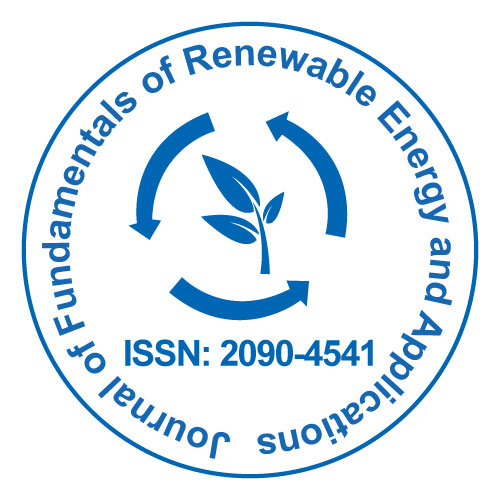
Journal of Fundamentals of Renewable Energy and Applications
Open Access
ISSN: 2090-4541
+44 1300 500008

ISSN: 2090-4541
+44 1300 500008
Perspective - (2023)Volume 13, Issue 2
Hydro energy's potential has emerged as a potentially significant resolve in a time when climate change and the need for renewable energy are the main problems. Hydroelectric power, commonly known as the collection of flowing streams produce energy, is not a new idea. However, as civilizations all over the world look for cleaner and more sustainable energy sources, its importance has expanded significantly in recent years. In the above part, they explore all aspects of hydro energy, including its advantages, drawbacks, and contribution to a cleaner future.
In human history, using water as an energy source has been practiced for many years. The strength of water's movement has excite of engineers and entrepreneurs for centuries, from ancient waterwheels grinding grain to modern hydroelectric dams providing lots of electricity. At a time when the world is struggling to make the vital transition away from fossil fuels, hydro energy offers an unmatched chance to meet rising energy needs while lowering greenhouse gas emissions.
Hydro energy has numerous advantages that go far beyond just producing power. Its reduced carbon footprint is one of its most important advantages. Hydro energy, in contrast to fossil fuelbased power generation, emits few greenhouse gas during operation, making it a crucial instrument in the fight against climate change. Hydroelectric power facilities also offer a consistent and dependable supply of electricity. Water flows are constant, as opposed to solar or wind power, which might fluctuate depending on the weather, ensuring an ongoing supply of electricity. Hydro electricity is a crucial resource for grid stability and energy security because of its dependability.
There are various forms of hydro energy, each of which has been adapted to certain geographical and environmental circumstances. For instance, run-of-the-river systems use turbines to direct a portion of a river's flow, producing energy without the need for huge dams or reservoirs. Because they have less of an impact on regional ecosystems and water levels, these systems are frequently regarded as being more environmentally friendly. On the other side, energy storage is a benefit of storage-based hydro systems, such as reservoirs built by dams. Excess energy can be used to pump water into the reservoir at times of high water flow or low demand, efficiently saving energy until it is required. When demand is at its highest, this stored energy can be released to stabilize the grid and lessen the need for other, less reliable energy sources.
While hydro energy has many advantages, there are also some drawbacks and potential environmental issues. Large dam building can cause habitat destruction, altered water flow patterns, and even community displacement. Such projects' environmental effects should be thoroughly evaluated and reduced through thorough planning and responsible development. Concerns regarding whether climate change may affect water supplies must also be taken into mind. The long-term viability of some hydro projects may be impacted by shifting precipitation patterns, altered snowmelt timetables, and variations in river flows. An all-encompassing strategy that considers environmental, social, and economic aspects is necessary to strike a balance between the advantages of hydro energy and these difficulties.
Hydro energy projects frequently interact with local communities and indigenous populations in addition to the technical concerns. In order to guarantee that these projects are supported by the communities they have an influence on, proper consultation, respect for traditional knowledge, and equitable benefit-sharing are necessary. When used properly, hydro energy can offer these areas the chance to grow their infrastructure, provide employment, and improve their quality of life. Innovation is influencing the future of hydro energy as technology develops. Small-scale hydro systems, sometimes referred to as micro-hydro or pico-hydro, are becoming more popular in rural areas and developing countries. They provide electricity to locations that were previously off the grid. Hydroelectric facilities are becoming more effective and environmentally friendly because of improvements in turbine design, materials, and control systems.
Hydro energy can also be combined with other renewable energy sources, including solar and wind, to create hybrid energy systems that can consistently generate electricity in a variety of weather situations. These developments highlight hydro energy's capacity in a dynamic energy environment. In the global search for sustainable energy sources, hydropower is a icon. It is a strong challenger in the fight against climate change because of its capacity to produce the dependable power, cut greenhouse gas emissions, and promote local development. However, a careful balancing act between energy requirements and environmental concerns is needed for the appropriate growth of hydropower.
Citation: Ella J (2023) Understanding the Prospect of Hydro Energy. J Fundam Renewable Energy Appl.13:315.
Received: 15-May-2023, Manuscript No. JFRA-23-26257 ; Editor assigned: 17-May-2023, Pre QC No. JFRA-23-26257 (PQ); Reviewed: 29-May-2023, QC No. JFRA-23-26257 ; Revised: 05-Jun-2023, Manuscript No. JFRA-23-26257 (R); Published: 14-Jun-2023 , DOI: 10.35248/2090-4541.23.13.315
Copyright: © 2023 Ella J. This is an open-access article distributed under the terms of the Creative Commons Attribution License, which permits unrestricted use, distribution, and reproduction in any medium, provided the original author and source are credited.